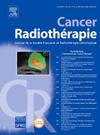Adaptive radiotherapy, promises and pitfalls
IF 1.4
4区 医学
Q4 ONCOLOGY
引用次数: 0
Abstract
Adaptive radiotherapy is a technique that adapts the radiotherapy to the changes of the patient's anatomy and tumour volume by using repeated images acquired during the treatment course. Adaptive radiotherapy aims to optimize the dose distribution, ensure that the tumour remains in the treatment volume and spare the organs at risk. Adaptive radiotherapy can be applied at three timescales: between fractions (offline), immediately before a fraction (online) or real-time (online, during a fraction). Over the last decade, manufacturers have developed linear accelerators dedicated to online adaptive radiotherapy, based on either computed tomography or magnetic resonance imaging. These systems allow for treatment plan adaptation according to deformable, registration-based segmentation and physicist-driven plan optimization. This has led to a rapid rise of this technique on a larger scale, although robust data on its benefits remains scarce. Adaptive radiotherapy has demonstrated dosimetric benefits, such as improved lesion coverage and sparing of organs at risk, in various tumour sites. However, the clinical benefit, in terms of toxicity reduction or improved tumour control, remains to be demonstrated in many disease sites. Furthermore, the implementation of adaptive radiotherapy requires careful planning, increased time, logistics and security, which represents an extra burden and impacts the cost-efficiency of the approach.
适应性放疗,承诺与陷阱
适应性放疗是一种利用在治疗过程中获得的重复图像,使放疗适应患者解剖结构和肿瘤体积变化的技术。适应性放疗的目的是优化剂量分布,确保肿瘤保持在治疗体积内,避免危及器官。适应性放疗可在三个时间尺度上应用:间隔时间(离线)、间隔时间之前(在线)或实时(在线,间隔时间期间)。在过去的十年中,制造商已经开发出用于在线自适应放疗的线性加速器,基于计算机断层扫描或磁共振成像。这些系统允许根据可变形的、基于注册的分割和物理学家驱动的计划优化来调整治疗计划。这导致了这种技术在更大范围内的迅速兴起,尽管关于其益处的可靠数据仍然很少。适应性放疗在不同肿瘤部位显示出剂量学上的益处,例如改善病变覆盖和保留危险器官。然而,在毒性降低或改善肿瘤控制方面的临床益处仍有待于在许多疾病部位得到证实。此外,实施适应性放射治疗需要仔细规划、增加时间、后勤和安全,这是额外的负担,并影响该方法的成本效益。
本文章由计算机程序翻译,如有差异,请以英文原文为准。
求助全文
约1分钟内获得全文
求助全文
来源期刊

Cancer Radiotherapie
医学-核医学
CiteScore
2.20
自引率
23.10%
发文量
129
审稿时长
63 days
期刊介绍:
Cancer/radiothérapie se veut d''abord et avant tout un organe francophone de publication des travaux de recherche en radiothérapie. La revue a pour objectif de diffuser les informations majeures sur les travaux de recherche en cancérologie et tout ce qui touche de près ou de loin au traitement du cancer par les radiations : technologie, radiophysique, radiobiologie et radiothérapie clinique.
 求助内容:
求助内容: 应助结果提醒方式:
应助结果提醒方式:


